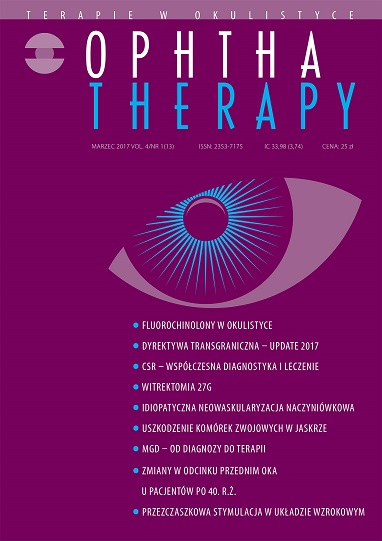Diagnostyka i leczenie centralnej surowiczej chorioretinopatii
##plugins.themes.bootstrap3.article.main##
Abstrakt
Centralna surowicza chorioretinopatia (CSR, CSCR) bywa przyczyną pogorszenia widzenia, w większości u mężczyzn między 20. a 55. r.ż. Charakteryzuje się odwarstwieniem neurosensorycznej siatkówki i gromadzeniem się płynu podsiatkówkowego w centrum plamki. Z występowaniem CSR mogą się wiązać: osobowość typu A, podatność na stres oraz leczenie glikokortykosteroidami. Diagnostyka CSR obejmuje angiografię fluoresceinową i tomografię optyczną, w niektórych przypadkach wymagana jest angiografia indocyjaninowa. CSR jest chorobą samoograniczającą się, jednak w ok. 20% przypadków może przejść w formę przewlekłą. Laseroterapia wraz z iniekcjami anty-VEGF są skutecznymi metodami leczenia CSR. Terapie lekami doustnymi wydają się obiecujące, lecz wymagają dalszych badań.
Pobrania
##plugins.themes.bootstrap3.article.details##

Utwór dostępny jest na licencji Creative Commons Uznanie autorstwa – Użycie niekomercyjne – Bez utworów zależnych 4.0 Międzynarodowe.
Copyright: © Medical Education sp. z o.o. License allowing third parties to copy and redistribute the material in any medium or format and to remix, transform, and build upon the material, provided the original work is properly cited and states its license.
Address reprint requests to: Medical Education, Marcin Kuźma (marcin.kuzma@mededu.pl)
Bibliografia
2. Islam QU, Hanif MK, Tareen S. Frequency of Systemic Risk Factors in Central Serous Chorioretinopathy. J Coll Physicians Surg Pak. 2016; 26(8): 692-5.
3. Nudleman E, Witmer MT, Kiss S et al. Central serous chorioretinopathy in patients receiving exogenous testosterone therapy. Retina. 2014; 34(10): 2128-32.
4. Carvalho-Recchia CA, Yannuzzi LA, Negrao S et al. Corticosteroids and central serous chorioretinopathy. Ophthalmology. 2002; 109(10): 1834-7.
5. Casella AM, Berbel RF, Bressanim GL et al. Helicobacter pylori as a potential target for the treatment of central serous chorioretinopathy. Clinics (Sao Paulo). 2012; 67(9): 1047-52.
6. Liew G, Quin G, Gillies M et al. Central serous chorioretinopathy: a review of epidemiology and pathophysiology. Clin Experiment Ophthalmol. 2013; 41(2): 201-14.
7. Zavoloka O, Bezditko P, Lahorzhevska I et al. Clinical efficiency of Helicobacter pylori eradication in the treatment of patients with acute central serous chorioretinopathy. Graefes Arch Clin Exp Ophthalmol. 2016; 254(9): 1737-42.
8. Gomolin JE. Choroidal neovascularization and central serous chorioretinopathy. Can J Ophthalmol. 1989; 24(1): 20-3.
9. Hua R, Yao K, Xia F et al. The hyper-fluorescent transitional bands in ultra-late phase of indocyanine green angiography in chronic central serous chorioretinopathy. Lasers Surg Med. 2016; 48(3): 260-3.
10. Chen SJ, Lee AF, Lee FL et al. Indocyanine green angiography of central serous chorioretinopathy. Zhonghua Yi Xue Za Zhi (Taipei). 1999; 62(9): 605-13.
11. Brandl C, Helbig H, Gamulescu MA. Choroidal thickness measurements during central serous chorioretinopathy treatment. Int Ophthalmol. 2014; 34(1): 7-13.
12. Tatham A, Macfarlane A. The use of propranolol to treat central serous chorioretinopathy: an evaluation by serial OCT. J Ocul Pharmacol Ther. 2006; 22(2): 145-9.
13. Nielsen JS, Jampol LM. Oral mifepristone for chronic central serous chorioretinopathy. Retina. 2011; 31(9): 1928-36.
14. Khan MS, Sameen M, Lodhi AA et al. Effect of half adult dose of oral Rifampicin (300 mg) in patients with idiopathic central serous chorioretinopathy. Pak J Med Sci. 2016; 32(5): 1158-63.
15. Shulman S, Goldenberg D, Schwartz R et al. Oral Rifampin treatment for longstanding chronic central serous chorioretinopathy. Graefes Arch Clin Exp Ophthalmol. 2016; 254(1): 15-22.
16. Kurup SK, Oliver A, Emanuelli A et al. Low-dose methotrexate for the treatment of chronic central serous chorioretinopathy: a retrospective analysis. Retina. 2012; 32(10): 2096-101.
17. Cakir B, Fischer F, Ehlken C et al. Clinical experience with eplerenone to treat chronic central serous chorioretinopathy. Graefes Arch Clin Exp Ophthalmol. 2016; 254(11): 2151-7.
18. Pichi F, Carrai P, Ciardella A et al.; Central Serous Chorioretinopathy Study Group. Comparison of two mineralcorticosteroids receptor antagonists for the treatment of central serous chorioretinopathy. Int Ophthalmol. 2016. https://doi.org/10.1007/ s10792-016-0377-2.
19. Robertson DM, Ilstrup D. Direct, indirect, and sham laser photocoagulation in the management of central serous chorioretinopathy. Am J Ophthalmol. 1983; 95(4): 457-66.
20. Watzke RC, Burton TC, Woolson RF. Direct and indirect laser photocoagulation of central serous choroidopathy. Am J Ophthalmol. 1979; 88(5): 914-8.
21. Naseripour M, Falavarjani KG, Sedaghat A et al. Half-dose Photodynamic Therapy for Chronic Central Serous Chorioretinopathy. J Ophthalmic Vis Res. 2016; 11(1): 66-9.
22. Breukink MB, Mohr JK, Ossewaarde-van Norel A et al. Half-dose photodynamic therapy followed by diode micropulse laser therapy as treatment for chronic central serous chorioretinopathy: evaluation of a prospective treatment protocol. Acta Ophthalmol. 2016; 94(2): 187-97.
23. Özmert E, Demirel S, Yanık Ö et al. Low-Fluence Photodynamic Therapy versus Subthreshold Micropulse Yellow Wavelength Laser in the Treatment of Chronic Central Serous Chorioretinopathy. J Ophthalmol. 2016; 2016: 3513794.
24. Tekin K, Sekeroglu MA, Cankaya AB et al. Intravitreal Bevacizumab and Ranibizumab in the Treatment of Acute Central Serous Chorioretihopathy: A Single Center Retrospective Study. Semin Ophthalmol. 2016; Nov 14: 1-6. https://doi.org/10.1080/08820538.2016.1228985
25. Pitcher JD 3rd, Witkin AJ, DeCroos FC, Ho AC. A prospective pilot study of intravitreal aflibercept for the treatment of chronic central serous chorioretinopathy: the CONTAIN study. Br J Ophthalmol. 2015; 99(6): 848-52.
26. Bae SH, Heo J, Kim C et al. Low-fluence photodynamic therapy versus ranibizumab for chronic central serous chorioretinopathy: one-year results of a randomized trial. Ophthalmology. 2014; 121(2): 558-65.

